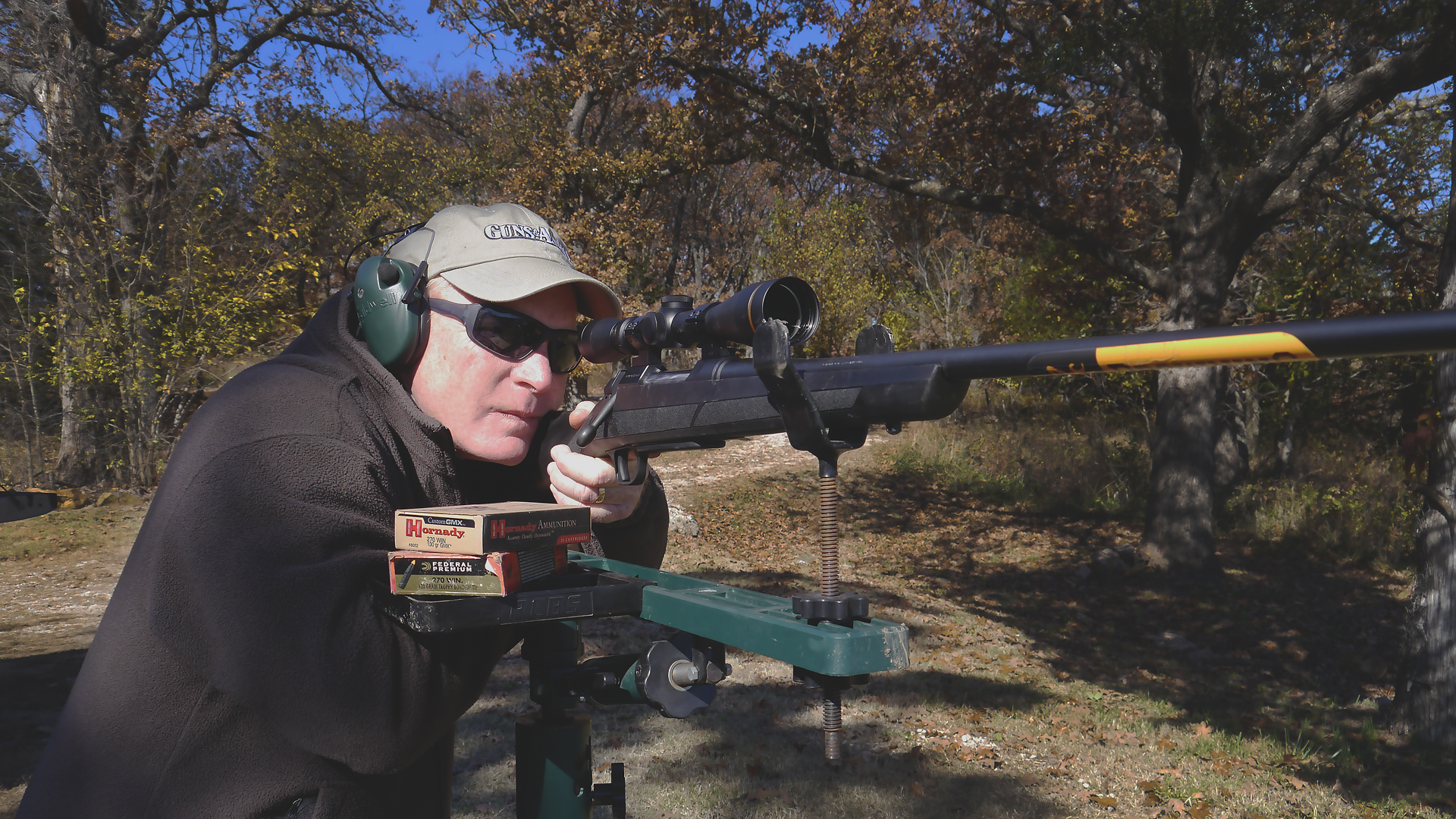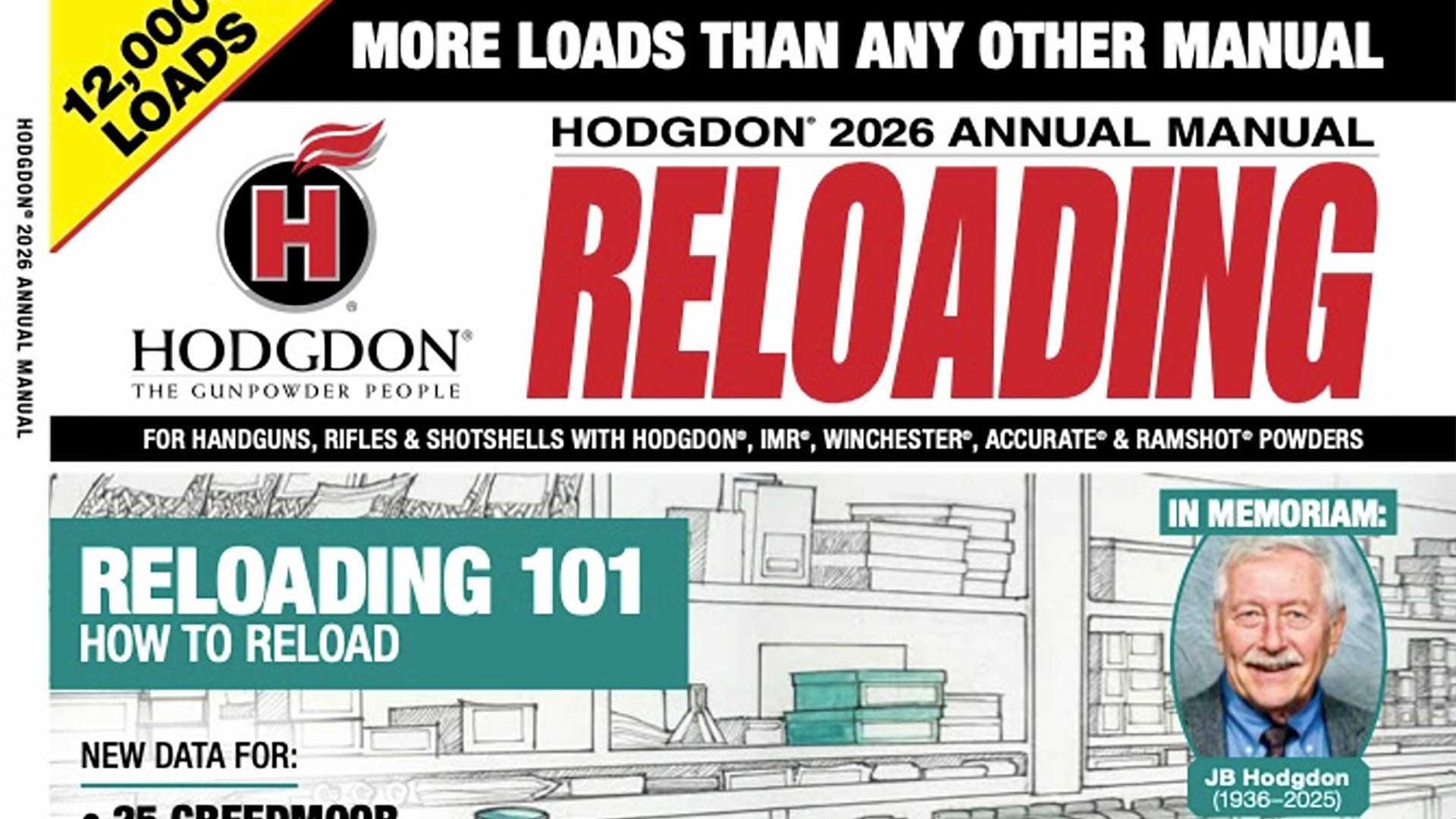
I’ve been doing this stuff for a long time, and I’ve been a gun fanatic since I was a kid. With a lifetime’s accumulation, it shouldn’t be surprising that I have a couple of nice rifles or that, as a lefty, I have a weakness for left-handed rifles. Not too long ago, I picked up a lovely rifle made by my old friend Joe Balickie, now retired. It’s a slim, trim .270 on a left-hand Carl Gustav action, with awesome walnut and a steel buttplate with trap; it shoots really well.
So far, I’ve only taken it pig hunting, but I look forward to more hunts with it. Maybe I’ll write about some of them. But when I do, know I’m going to get letters. It’s just like every time I use a “nice” rifle, whether it’s my personal one or a sample gun sent by manufacturer for testing, I’m always asked, “Why don’t you write about guns the average person can afford?”
 Introduced in 2011, the Ruger American was an unabashed—and very successful—effort to insert Ruger into the basic bolt gun market. First seen with a group of writers at the SAAM shooting school, the author and colleagues tested a dozen Ruger American rifles out to 1,000 yards with very little difficulty. Photo by author.
Introduced in 2011, the Ruger American was an unabashed—and very successful—effort to insert Ruger into the basic bolt gun market. First seen with a group of writers at the SAAM shooting school, the author and colleagues tested a dozen Ruger American rifles out to 1,000 yards with very little difficulty. Photo by author.
The problem is, in my business, I just can’t win. Ironically, I do use, and write about, inexpensive production rifles a lot. And all hunts are important to me, too. While there’s never just one ideal choice for a rifle, I like to be properly armed. Various factors do place some hunts with a higher importance than others. For example: In 2008, I drew an Arizona desert sheep tag. It was the 30th year I’d applied, and the draw limit is one per lifetime. For that hunt, I used a utilitarian CZ bolt action in .270 Win. Two years ago, I finally choked it up and went on a polar bear hunt, a demanding and costly undertaking. I used a Mossberg Patriot in .375 Ruger. Both rifles from those hunts performed perfectly. After all, on any sheep hunt, what’s wrong with a .270 Win.? And in the Arctic, that Patriot was laminate and stainless steel. Here came the letters: “Why did you use that (silent ‘ugh’) rifle on a hunt like that?”
The easy answer is: Because I knew they’d work. But, obviously, it’s a “Catch 22” scenario for me. If I use and write about nice rifles, I’m a snob. If I use and write about basic rifles, then other snobs jump all over me. But relatively few of us start at the top of the food chain with custom work or premium production rifles. Jack O’Connor’s first centerfire was a surplus Krag; my first centerfire was a surplus Springfield. For generations of Americans, “sporterized” military bolt-actions were common “first centerfire rifles.”
 Across North America the basic bolt-action has become the most popular hunting rifle. A nice Montana whitetail, shown above, taken with a CZ 557 in .270 Winchester. Author-supplied photo.
Across North America the basic bolt-action has become the most popular hunting rifle. A nice Montana whitetail, shown above, taken with a CZ 557 in .270 Winchester. Author-supplied photo.
In new production rifles, the good old lever-action was the least expensive and most popular choice. A Model 94 in .30-30 Win. was my dad’s first centerfire, likewise for millions of Americans from the 1890s until, well, I guess that’s the story. In 1964, when Dad got his .30-30, the cost was twice that of a surplus Springfield—about 80 bucks. Production bolt-actions were more expensive and weren’t common as starter rifles.
Times do change. Supplies of military bolt-actions seemingly dried up years ago; rifles from World War II, and before, now have collector value and are best left alone in the safe. Manufacturing processes, too, have changed. The good old American lever-action has a lot of parts and is costly to manufacture. Also, the landscape has changed. The Savage 99, long a sound option to a bolt-action, is gone, likewise Winchester’s Model 88. Browning’s BLR is awesome, but it’s a premium rifle. The Winchester 94 was gone but now is back. The Marlin was briefly gone but is currently coming back. Henry offers a great selection of lever-action centerfires, but the least expensive of current lever-action “deer rifles” is probably Mossberg’s 464.
 The author used a basic CZ in .270 Win. when he drew an Arizona desert sheep tag in 2008. The shot was made perfectly at 250 yards, completing the high-stakes hunt of a lifetime. Author-supplied photo.
The author used a basic CZ in .270 Win. when he drew an Arizona desert sheep tag in 2008. The shot was made perfectly at 250 yards, completing the high-stakes hunt of a lifetime. Author-supplied photo.
So, guess what? Today, there are a lot of new production bolt-actions on dealers’ shelves at prices well below new lever-actions. The current Winchester 1894 carbine is gorgeous, but it costs $1,200. It retains the appeal of charisma, nostalgia and tradition, but for most of us, this is no longer a first, or basic, rifle. There is a wide world of bolt-actions, many far beyond “basic,” that are well below this price range. This doesn’t mean the lever-action is dead. Rather, instead of holding the title as America’s favorite deer rifle, the lever-action is falling into specialized niches: Close cover; cowboy action; houndsmen; “guide guns;” or simply those who place a premium on charisma, nostalgia and tradition. The bolt-action has come to the fore as the first rifle, the basic rifle, the most popular hunting rifle and one of the least-expensive choices.
The Affordable Bolt-Action
The concept of an inexpensive bolt-action hunting rifle isn’t exactly new. Enablers, to some extent, were the post-WWII push-feed actions, which are simpler and thus cheaper to manufacture than Mauser-type controlled-round feed actions; and, a generation later, widespread acceptance of synthetic stocks. As far as material goes, synthetic is cheaper than wood and supplies are unlimited; it’s also easier and thus less-costly to mass-produce synthetic stocks.
 A decade ago (the above) Savage 110 “package” with 3-9X mounted scope was the least expensive production bolt gun. Accuracy was consistently good, but the author found it to be exceptional with Federal’s 180-grain Barnes bullet (bottom center). Photo by author.
A decade ago (the above) Savage 110 “package” with 3-9X mounted scope was the least expensive production bolt gun. Accuracy was consistently good, but the author found it to be exceptional with Federal’s 180-grain Barnes bullet (bottom center). Photo by author.
Too, the bolt-action has a lot going for it. A bolt-action can easily accommodate an adjustable trigger system, and it can house a wider selection of cartridges than any other action type except the single-shot. The most prevalent one-piece stock design is conducive to accuracy and can accommodate a variety of bedding options, including free-floating, which is the least expensive to produce, yet often produces exceptional accuracy.
I think Savage led the way in the affordable bolt-action race. The old Savage 110 was not the sleekest bolt-action on the market, but it was generally the least expensive—and shot well. When I was a junior editor at Guns & Ammo, now nearly 40 years ago, the whisper in the hallways was: “If you want a factory bolt-action that will really shoot, get a Savage.”
 Savage was one of the first to offer a package rifle with scope. The author (shown above) used a left-hand Savage 110 in .30-06 to drop a bull elk with a single 180-grain Barnes X bullet. Author-supplied photo.
Savage was one of the first to offer a package rifle with scope. The author (shown above) used a left-hand Savage 110 in .30-06 to drop a bull elk with a single 180-grain Barnes X bullet. Author-supplied photo.
Savage was also among the first to offer “package” rifles that came with a basic rifle, inexpensive scope set in rings, ready to be zeroed and hunted with right out of the box. Sure, the scope didn’t compare with the best German glass, but for a few hundred bucks, it was ready to go. Some years ago, I got one in .30-06 Sprg. and took it to the range. With the packaged scope, it produced 0.25” groups with 180-grain Barnes X bullets. I took it on a late hunt in northwestern Colorado, and on a day when the thermometer read -20° Fahrenheit at dawn, I flattened a bull elk with one shot. A few years ago, one of my most recent elk hunts, I reprise that event with a Savage 116, also in .30-06, not quite as accurate but almost. It accounted for a nice Montana bull at 350 yards.
The Savage 110 action is still with us in a wide variety of configurations, but prices have inexorably climbed, with a number of them pushing, and some exceeding the $1,000 mark. Savage, however, remains very much in the budget bolt-action game. Their most basic Axis bolt-action carries a retail of $419, one of the lowest MSRPs around. The Axis uses a slightly modified M110-series action, but it does not have the excellent AccuTrigger of the 110 series. Another major plus, for folks like me, is that Savage has always been good to lefties: The Axis is available with a left-hand bolt without premium pricing.
 The Sauer Model 100 is at the upper end of the “basic bolt-action” spectrum, but is an amazing rifle for the price—and perhaps for any price. This Sauer M100 in .270 is both exceptionally and consistently accurate. Photo by author.
The Sauer Model 100 is at the upper end of the “basic bolt-action” spectrum, but is an amazing rifle for the price—and perhaps for any price. This Sauer M100 in .270 is both exceptionally and consistently accurate. Photo by author.
Race To The Bottom
It sounds unkind, but in recent years, virtually all manufacturers have scrambled—and competed against one another—to bring to market the least expensive bolt-actions possible. In most cases, these same manufacturers continue to offer higher-priced models, but several things seem obvious: First, the ascendancy of the basic bolt-action as a primary entry-level centerfire. Second, utilization of modern manufacturing techniques and materials enable reduced costs. Third, this is a race no one can definitively win!
MSRPs are seductive, and on-the-street prices are generally less, but vary depending on volume, terms, dealer incentives and so forth. There’s also packaging. Some rifles come with scope bases, others with mounted scopes, so the raw price doesn’t always tell the story. There are also brand perceptions, and a lot of gun folks have brand loyalties that transcend a couple of sawbucks. Reality, however, is that all of these inexpensive bolt-actions are good . . . and some of them are so good that it makes it harder to justify popping for higher-priced models, let alone a serious custom job.

Mossberg’s Patriot is available in numerous ascending options. This one, stainless and laminate in .375 Ruger, was priced a bit above the basic Patriot. With an Aimpoint Micro H2, this is the Patriot the author used for his polar bear hunt. Shown (inset) is Mossberg’s use of a two-piece bolt with Mauser-type dual-opposing locking lugs. Photo by author.
I don’t intend to go through a full litany of makes and models and options, but some of today’s basic bolt guns are fairly new, an obvious effort to cash in on a serious market. Others have been around for a while. The Weatherby Vanguard, for example, pre-dates this entire trend. The Vanguard is in the upper middle of the basic bolt-gun spectrum. Using a different action, it’s an altogether separate platform from Weatherby’s flagship Mark V with significant price separation between them. The Vanguard has a strong reputation for fine accuracy, and of course, in raw volume, sales greatly exceed the Mark V.
Introduced in 2011, the Ruger American was specifically designed for the basic bolt-gun market. Instigated by Ruger’s then-CEO, Mike Fifer, the American was designed from the ground up around his specialty: “lean manufacturing.” About the only thing it has in common with Ruger’s Model 77 is they’re both bolt-action rifles. It has an oversize bolt with three locking lugs, rotary polymer magazine, tang safety and comes supplied with Weaver bases. Current MSRP for the American starts at $599. Accuracy is generally excellent and often exceptional; the original centerfire American has spawned quite a family and has been a great success for Ruger.
 The Remington M783 is quite different from the flagship M700 and comes at about half the cost. The M783 (shown above) came with a 3-9X scope and the author found its accuracy with Remington ammo to be amazing.
The Remington M783 is quite different from the flagship M700 and comes at about half the cost. The M783 (shown above) came with a 3-9X scope and the author found its accuracy with Remington ammo to be amazing.
The Mossberg Patriot is a fairly straightforward rifle offered in a wide variety of configurations. It has a two-lug bolt, two-position safety and detachable polymer box magazine, so it is actually a very conventional rifle. In its most basic configuration with synthetic stock, the Patriot starts at an MSRP of $468 with Weaver bases installed. It goes on up the scale, so it depends on what you want, and need.
Once you get into the, say, $550 to $750 range—same strata as the Vanguard, and below most current lever-actions—there are a number of excellent bolt-actions that we might not think of as either basic or entry-level, but are so darned good that they should be considered extremely solid values. Several of these comes from brand names that you might normally associate with premium-quality rifles. This is also worth mentioning, because I’ve used a number of these rifles; the only thing about them that isn’t premium is the price. These would include: Browning AB3; CZ 600 series; Sako A7; Sauer 100; Tikka T3x; Weatherby Vanguard; and Winchester XPR. Consider all these rifles together—and without doubt several I’ve missed—and we really do have a bolt-action revolution!
 The Weatherby Vanguard lies at the upper end of the ‘basic bolt-action’ spectrum, but has been part of the Weatherby line for many years. The author found the above .257 Wby. Mag. to shoot fine, but “select” Vanguards are available with a sub-m.o.a. guarantee.
The Weatherby Vanguard lies at the upper end of the ‘basic bolt-action’ spectrum, but has been part of the Weatherby line for many years. The author found the above .257 Wby. Mag. to shoot fine, but “select” Vanguards are available with a sub-m.o.a. guarantee.
How Do They Do It?
Honestly, I just don’t know. That custom Joe Balickie .270 I mentioned was built more than 30 years ago. It still groups solidly under one m.o.a. with factory ammo. That wasn’t routine back then, nor is it today, but one probably has a right to expect such accuracy from a rifle costing several times a basic factory rifle. If I wanted to put together a rifle that was certain to provide exceptional accuracy, I’d start with a select, match-grade barrel. Such a tube might cost $500, which is more than the total cost of some of the complete rifles we’re talking about.
I can’t say that you can purchase any of these rifles and be assured of m.o.a. accuracy, but I can say that I’ve shot examples of most of them. Some were finickier than others, and certainly not all would do it, but a whole bunch of them did it with one load or another. And even the worst of them were plenty accurate for most sporting purposes. Considering an entire rifle retailing for less than a really good barrel, the manufacturers can’t have more than $30 in the barrel…and yet the accuracy is consistently okay, frequently great and sometimes spectacular. As far as functioning, I haven’t seen any problems. These basic rifles are typically all push-feed actions, sometimes not as smooth as highly polished actions, but they work.

I find it kind of frustrating, actually. I really like nice rifles. At their best, they may offer a bit more consistent accuracy, but these days, the basic bolt-action is so good that, by paying a whole lot more money, all you can really count on are intangibles that have little to do with function: Fit and finish, beautiful wood, personal touches, pride of ownership. These are things that no game animal is likely to notice.





































